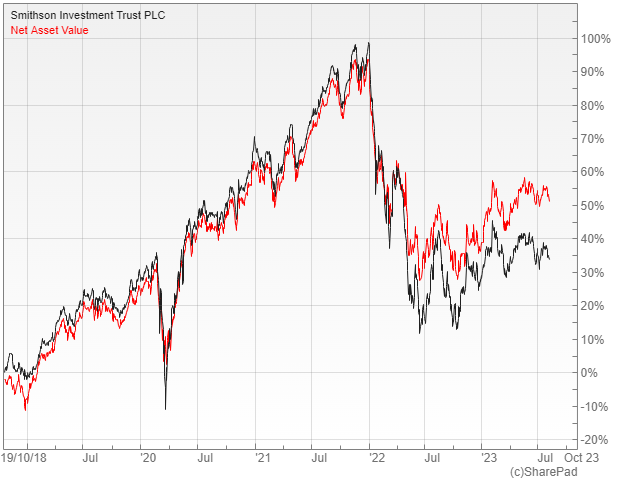Buy Rating For Smithson

It has been an interesting first few years for the £2.5bn Smithson (LON: SSON), which became the largest investment trust IPO when it floated in October 2018. Terry Smith’s quality growth strategy had a strong start and quickly shrugged off the dip during the pandemic, but suffered a sharp de-rating in the early part of 2022 and remains well below its all-time high of just over £20 per share.
The latest accounts for the six months to the end of June indicate a healthy period of outperformance with NAV and shareholder total returns of 11.7% and seven percent respectively, compared to a benchmark gain of 1.9%. Its longer term numbers are also impressive with an NAV increase since launch of 59%, which is well ahead of the 41.4% achieved by the index.
Smithson has a clear investment philosophy and process that is augmented with a high conviction approach. The focus is on the identification of high-quality, well established global mid and small-cap companies that are capable of delivering sustainable growth and which can compound value over the long-term.
The Underlying Portfolio
Portfolio construction is driven by stock selection and can be summed up by the mantra: “buy good companies, don’t overpay and then do nothing”. The managers aim to identify shares that can deliver sustainable high returns on capital employed and generate substantial free cash flow, with some of the excess reinvested back into the business.
These stocks typically rely on intangible assets such as brand names, patents, customer relationships, distribution networks, captive markets for services and spares, or dominant market positions. They generally have low levels of debt given the healthy cash generation, with returns on invested capital and interest cover materially higher than that of the benchmark.
The upshot is an incredibly concentrated portfolio of just 33 holdings with an average market cap of £6.8bn. Of these, the largest individual positions make up five percent of the assets, with the top ten accounting for 42.1% of the total. It is a bottom up approach that in the last year has resulted in an increase in industrial exposure from 19% to 33% and a reduction in technology from 44% to 32%.
Valuation Opportunity?
During those first few years Smithson typically traded at a small premium to NAV, but the sell-off at the start of 2022 meant that it de-rated sharply and is currently available at a 12% discount. There is nothing unique in this with the same thing happening both to its immediate peer group and the wider closed-ended sector.
Since the start of the buyback program last June, the Board has bought 11.7m shares into treasury, equivalent to 6.6% of those in issue at a cost of £158m. Writing in the accounts, the chairman said that buybacks provide NAV accretion and can have a positive effect on share price volatility and market spreads.
The broker Investec likes the quality growth philosophy and says that the fundamental attractions are enhanced by the current discount, hence their buy recommendation. There is no reason why the fund can’t deliver further strong performance in the current macro-economic environment, although interest rates may need to peak before investor sentiment picks up enough to substantially improve the rating.

Comments (0)